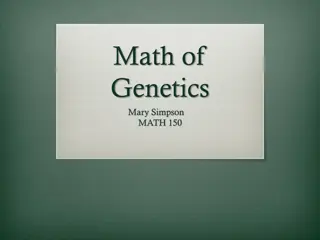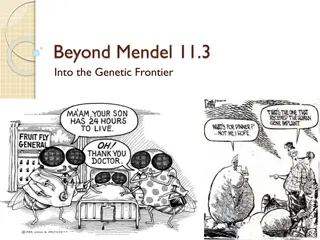Understanding Incomplete and Co-dominance in Genetics
Phenotypes and genotypes play crucial roles in understanding incomplete dominance and co-dominance. In incomplete dominance, alleles blend to produce a new phenotype, while in co-dominance, both alleles are expressed equally. Examples and problems illustrate these concepts further, aiding in genetic understanding.
Download Presentation

Please find below an Image/Link to download the presentation.
The content on the website is provided AS IS for your information and personal use only. It may not be sold, licensed, or shared on other websites without obtaining consent from the author. Download presentation by click this link. If you encounter any issues during the download, it is possible that the publisher has removed the file from their server.
E N D
Presentation Transcript
Important Terms Phenotype: This is the "outward, physical manifestation" of the organism Genotype: This is the "internally coded, inheritable information" carried by all living organisms. This stored information is used as a "blueprint" or set of instructions for building and maintaining a living creature. Homozygous: The gene for seed shape in pea plants exists in two forms, one form or allele for round seed shape (R) and the other for wrinkled seed shape (r). A homozygous plant would contain the following alleles for seed shape: (RR) or (rr). When the Genotype is made up of one capital letter & one lowercase letter (ex: Tt) it's called heterozygous ("hetero" means "other").
INCOMPLETE DOMINANCE Incomplete dominance is a form of intermediate inheritance in which one allele for a specific trait is not completely dominant over the other allele. With incomplete dominance, a cross between organisms with two different phenotypes produces offspring with a third phenotype that is a blending of the parental traits.
Example Incomplete dominance is seen in cross-pollination experiments between red and white snapdragon plants. The dominant allele that produces the red color is not completely expressed over the recessive allele that produces the white color. The resulting offspring are pink.
Problems on incomplete dominance 1. A cross between a blue blahblah bird & a white blahblah bird produces offspring that are silver. The color of blahblah birds is determined by just two alleles. a) What are the genotypes of the parent blahblah birds in the original cross? b. What is/are the genotype(s) of the silver offspring? c. What would be the phenotypic ratios of offspring produced by two silver blahblah birds?
2. The color of fruit for plant "X" is determined by two alleles. When two plants with orange fruits are crossed the following phenotypic ratios are present in the offspring: 25% red fruit, 50% orange fruit, 25% yellow fruit. What are the genotypes of the parent orange-fruited plants?
CO-DOMINANCE First let me point out that the meaning of the prefix "co-" is "together". Cooperate = work together. Coexist = exist together. Cohabitat = habitat together. The genetic gist to codominance is pretty much the same as incomplete dominance. A hybrid organism shows a third phenotype --- not the usual "dominant" one & not the "recessive" one ... but a third, different phenotype.
With incomplete dominance we get a blending of the dominant & recessive traits so that the third phenotype is something in the middle (red x white = pink). In Co-dominance, the "recessive" & "dominant" traits appear together in the phenotype of hybrid organisms.
An example cross R= allele for red flowers W= allele for white flowers red x white ---> red & white spotted RR x WW ---> 100% RW
Problems on Co-dominance Predict the phenotypic ratios of offspring when a homozygous white cow is crossed with a roan bull. What should the genotypes & phenotypes for parent cattle be if a farmer wanted only cattle with red fur?
Test Cross In genetics, a test cross, first introduced by Mendel, is used to determine if an individual exhibiting a dominant trait is homozygous or heterozygous for that trait. Put more simply test crosses determine the genotype of an individual with a dominant phenotype. Test crosses involve breeding the individual in question with another individual that expresses a recessive version of the same trait. If all offspring display the dominant phenotype, the individual in question is homozygous dominant; if the offspring display both dominant and recessive phenotypes, then the individual is heterozygous.























